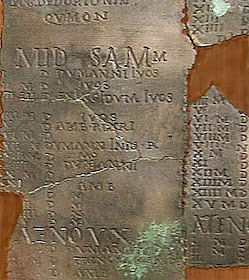by Mark Patton
The Coligny Calendar is an engraved copper alloy tablet which was originally 1.48 metres wide and 0.9 metres high. It is broken and incomplete, but the 73 fragments preserved in the Gallo-Roman Museum in Lyon gives us a great deal of information about how the calendar was structured. It dates to the late 2nd Century AD, by which time Lyon and its surrounding district was, in most respects, thoroughly Romanised, yet the months it lists are not the familiar ones of the Julian Calendar.
Presumably it mattered, at least to some people, to keep in mind the calendar of their pre-Roman ancestors. Since Julius Caesar and other writers emphasise the unity of Gaulish and British culture, with druids moving freely across tribal boundaries, the likelihood is that this calendar, or some variant of it, applied in Britain just as it did in Gaul.
The Coligny Calendar (photo: D. Bachmann - image is in the public domain).
Detail of the Coligny Calendar (photo: NantonosAedui, licensed under CCA).
The list below shows the names of the months (in the Gaulish language), the equivalents in our calendar, and suggested translations (academics do not always agree on these).
Samonios: October/November: Seed-Fall.
Dumannios: November/December: Darkest Depths.
Riuros: December/January: Cold-Time.
Anagantios: January/February: Stay-Home Time.
Ogronios: February/March: Time of Ice.
Cutios: March/April: Time of Winds.
Giamonios: April/May: Shoot-Show.
Simivisionios: May/June: Time of Brightness.
Equos: June/July: Horse Time.
Elembivos: July/August: Claim Time.
Edrinios: August/September: Arbitration Time.
Cantios: September/October: Song Time.
The years are grouped into five year cycles, and these five year cycles are in turn grouped into "ages" of thirty years, which corresponds to what Pliny the Elder has to say about the druidic understanding of the passage of time. Intercalary months were added in some years to synchronise the solar and lunar cycles (as with modern "leap years").
The major festivals within the year were Samhain (31st October, when all household fires were extinguished, and re-lit from a ceremonial bonfire); Imbolc (1st February, marking the return of light to the world); Bealtaine (1st May, the feast of Belenos, God of Fire); and Lughnasa (1st August; a harvest festival, at which marriages were also celebrated).
It is impossible to know how far back in time this calendar extends. I use it alongside the Roman calendar in my novel, An Accidental King (set in the 1st Century AD), but invented a different one for the world of Undreamed Shores (set almost two and a half thousand years earlier).
~~~~~~~~~~~~
Mark Patton's novels, Undreamed Shores and An Accidental King, are published by Crooked Cat Publications. Further information can be found on his website (www.mark-patton.co.uk) and blog (http://mark-patton.blogspot.co.uk).


What a fascinating article. Many thanks.
ReplyDeleteYes, fascinating is the only word. Thanks, Mark
ReplyDeleteI liked this, Mark. I thought the names, even if there is disagreement about them, were highly charged and poetic.
ReplyDeleteThis is fascinating! What a find!
ReplyDelete